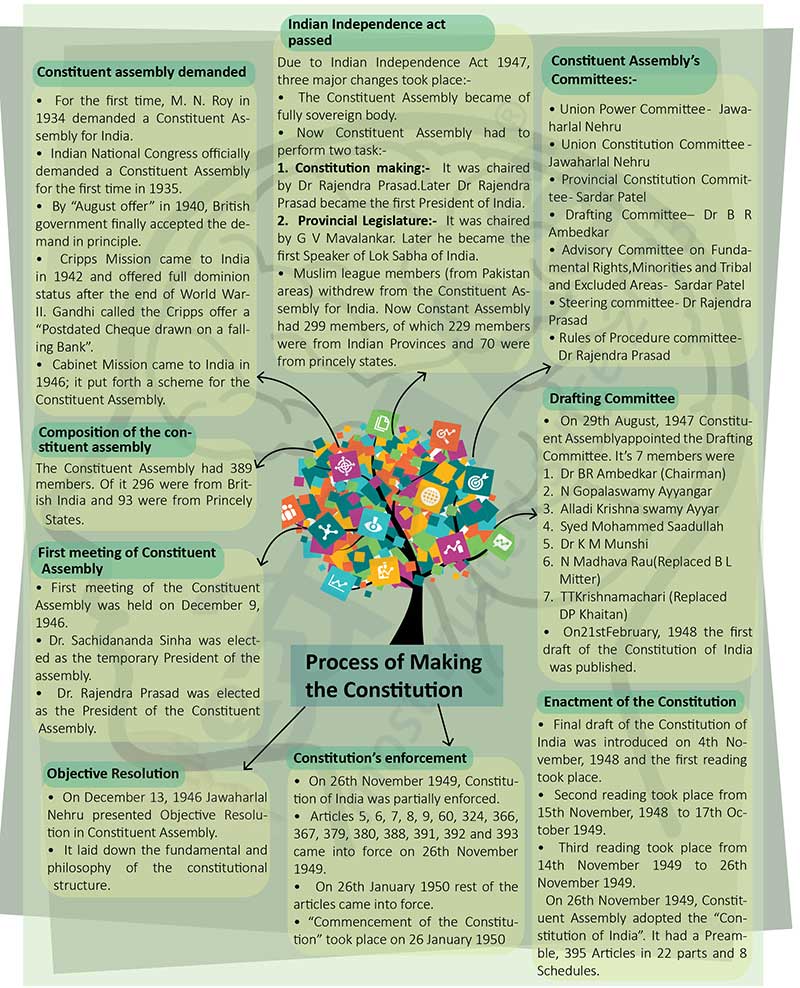Constituent assembly demanded
- For the first time, M. N. Roy in 1934 demanded a Constituent Assembly for India.
- Indian National Congress officially demanded a Constituent Assembly for the first time in 1935.
- By “August offer” in 1940, British government finally accepted the demand in principle.
- Cripps Mission came to India in 1942 and offered full dominion status after the end of World War-II. Gandhi called the Cripps offer a “Postdated Cheque drawn on a falling Bank”.
- Cabinet Mission came to India in 1946; it put forth a scheme for the Constituent Assembly.
Composition of the constituent assembly
- The Constituent Assembly had 389 members. Of it 296 were from British India and 93 were from Princely States.
First meeting of Constituent Assembly
- First meeting of the Constituent Assembly was held on December 9, 1946.
- Dr. Sachidananda Sinha was elected as the temporary President of the assembly.
- Dr. Rajendra Prasad was elected as the President of the Constituent Assembly.
Objective Resolution
- On December 13, 1946 Jawaharlal Nehru presented Objective Resolution in Constituent Assembly.
- It laid down the fundamental and philosophy of the constitutional structure.
Indian Independence act passed
Due to Indian Independence Act 1947, three major changes took place:-
- The Constituent Assembly became of fully sovereign body.
- Now Constituent Assembly had to perform two task:-
- Constitution making:- It was chaired by Dr Rajendra Prasad.Later Dr Rajendra Prasad became the first President of India.
- Provincial Legislature:- It was chaired by G V Mavalankar. Later he became the first Speaker of Lok Sabha of India.
- Muslim league members (from Pakistan areas) withdrew from the Constituent Assembly for India. Now Constant Assembly had 299 members, of which 229 members were from Indian Provinces and 70 were from princely states.
Constitution’s enforcement
- On 26th November 1949, Constitution of India was partially enforced.
- Articles 5, 6, 7, 8, 9, 60, 324, 366, 367, 379, 380, 388, 391, 392 and 393 came into force on 26th November 1949.
- On 26th January 1950 rest of the articles came into force.
- “Commencement of the Constitution” took place on 26 January 1950
Constituent Assembly’s Committees:-
- Union Power Committee - Jawaharlal Nehru
- Union Constitution Committee -Jawaharlal Nehru
- Provincial Constitution Committee- Sardar Patel
- Drafting Committee– Dr B R Ambedkar
- Advisory Committee on Fundamental Rights, Minorities and Tribal and Excluded Areas - Sardar Patel
- Steering committee - Dr Rajendra Prasad
- Rules of Procedure committee -Dr Rajendra Prasad
Drafting Committee
- On 29th August, 1947 Constituent Assembly appointed the Drafting Committee. It’s 7 members were
- Dr BR Ambedkar (Chairman)
- N Gopalaswamy Ayyangar
- Alladi Krishna swamy Ayyar
- Syed Mohammed Saadullah
- Dr K M Munshi
- N Madhava Rau (Replaced B L Mitter)
- T T Krishnamachari (Replaced DP Khaitan)
- On21stFebruary, 1948 the first draft of the Constitution of India was published.
Enactment of the Constitution
- Final draft of the Constitution of India was introduced on 4th November, 1948 and the first reading took place.
- Second reading took place from 15th November, 1948 to 17th October 1949.
- Third reading took place from 14th November 1949 to 26th November 1949.
On 26th November 1949, Constituent Assembly adopted the “Constitution of India”. It had a Preamble, 395 Articles in 22 parts and 8 Schedules.







